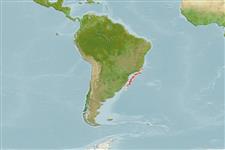Élasmobranches (requins et raies) (sharks and rays) >
Rajiformes (Skates and rays) >
Gurgesiellidae (Pygmy skates)
Etymology: Gurgesiella: Latin, gurges = abyss, whirlpool (Ref. 45335).
Environment: milieu / climate zone / depth range / distribution range
Écologie
marin bathydémersal; profondeur 470 - 800 m (Ref. 57911). Deep-water; 20°S - 40°S, 60°W - 40°W (Ref. 57911)
Southwest Atlantic: Brazilian coast, from Rio de Janeiro to Rio Grande do Sul.
Taille / Poids / Âge
Maturity: Lm ? range ? - ? cm
Max length : 53.0 cm TL mâle / non sexé; (Ref. 57911); common length : 19.0 cm WD mâle / non sexé; (Ref. )
Holotype taken from a depth of 800 m (Ref. 26282). Oviparous (Ref. 50449). Eggs have horn-like projections on the shell (Ref. 205). Feeds on fishes and crustaceans (Ref. 57911). Max. width (Teodoro Vaske Jr., pers. comm., 2002).
Life cycle and mating behavior
Maturité | Reproduction | Frai | Œufs | Fécondité | Larves
Oviparous, paired eggs are laid. Embryos feed solely on yolk (Ref. 50449).
McEachran, J.D. and K.A. Dunn, 1998. Phylogenetic analysis of skates, a morphologically conservative clade of elasmobranchs (Chondrichthyes: Rajidae). Copeia 1998(2):271-290. (Ref. 27314)
Statut dans la liste rouge de l'IUCN (Ref. 130435: Version 2024-1)
Menace pour l'homme
Harmless
Utilisations par l'homme
Outils
Articles particuliers
Télécharger en XML
Sources Internet
Estimates based on models
Preferred temperature (Ref.
123201): 4.9 - 10.1, mean 6.9 °C (based on 13 cells).
Phylogenetic diversity index (Ref.
82804): PD
50 = 0.6250 [Uniqueness, from 0.5 = low to 2.0 = high].
Bayesian length-weight: a=0.00661 (0.00222 - 0.01969), b=2.95 (2.71 - 3.19), in cm total length, based on LWR estimates for this (Sub)family-body shape (Ref.
93245).
Niveau trophique (Ref.
69278): 4.0 ±0.66 se; based on food items.
Résilience (Ref.
120179): Faible, temps minimum de doublement de population : 4,5 à 14 années (Fec assumed to be <100).
Fishing Vulnerability (Ref.
59153): Moderate vulnerability (41 of 100).
